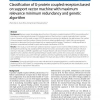35 search results - page 4 / 7 » Graphical Models of Residue Coupling in Protein Families |
BMCBI
2002
13 years 5 months ago
2002
Background: Most profile and motif databases strive to classify protein sequences into a broad spectrum of protein families. The next step of such database studies should include ...
CSB
2004
IEEE
13 years 9 months ago
2004
IEEE
One goal of the structural genomics initiative is the identification of new protein folds. Sequence-based structural homology prediction methods are an important means for priorit...
BMCBI
2010
13 years 5 months ago
2010
Background: Phosphorylation events direct the flow of signals and metabolites along cellular protein networks. Current annotations of kinase-substrate binding events are far from ...
BMCBI
2010
13 years 5 months ago
2010
Background: Because a priori knowledge about function of G protein-coupled receptors (GPCRs) can provide useful information to pharmaceutical research, the determination of their ...
BIBM
2008
IEEE
13 years 12 months ago
2008
IEEE
Abstract—The exact relationship between protein active centers and protein functions is unclear even after decades of intensive study. To improve the functional prediction abilit...

